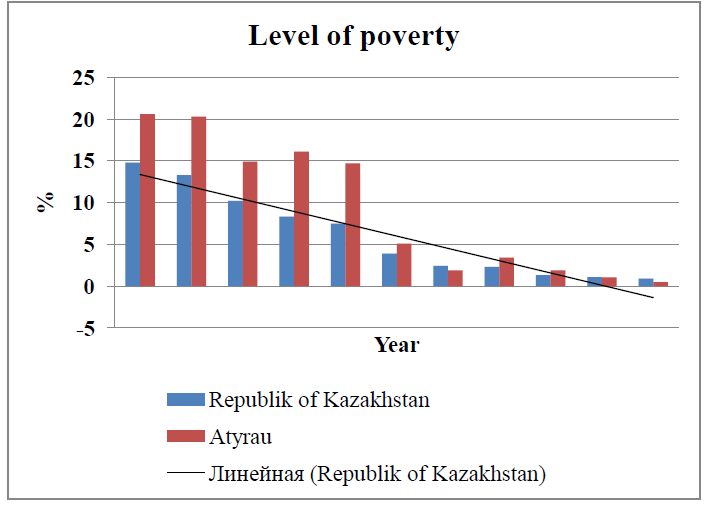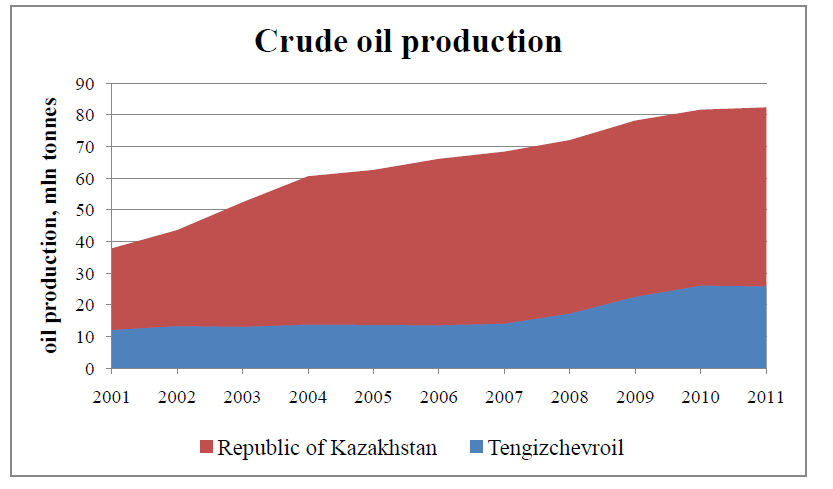CSR has a great potential in Kazakhstan, although since its early days it has been used by the multinational corporation as a philanthropy act in order to enter the field of their interest. With time it has become an obligation, when the government signs the contract with big corporations one of the major points to be discussed in detail is the social responsibility of the organization to the region they are planning to enter. Tenghizchevroil from the time it has entered Atyrau region has held its position as a leader in the area of corporate social responsibility.
The main driver behind Kazakhstan's economic growth has been foreign investment, mainly in the country's booming oil and natural gas industries. Since independence from Soviet rule in 1991, Kazakhstan has received more than 18 bln. USS in 2010 of foreign direct investment - the highest per capita indicator in the former Eastern Bloc. So most of the country’s foreign investments have been directed to Atyrau region.
Part 1 of the article describes the main region in the oil and gas industry of Kazakhstan. Part 2 of the paper gives a brief description of the company that has been selected as a case, TCO. Part 3 consists of description of CSR activites of the company. Finally, the conclusion and recommendations regarding the proper CSR execution in Kazakhstan.
Atyrau region
The city of Atyrau (up until 1992 was called Guryev) was found in 1640 by the merchant Mikhailo Guryev, which then was called Yaitsk, and was renamed in 1708 to Guryev.
In the West the district borders Astrakhan district of the Russian Federation; in the north with the Western- Kazakhstan district; in the east with the Aktobe district; and in the southeast up to the Ustyurt plateau in the Mangistau district. The district is bounded by the waters of the Caspian Sea [1]. Occupies a territory of over 118 thousand sq. km. The length of the border from the north to the south is 350 km; from the east to the west it is more than 600 km. The climate is extreme continental, despite the proximity of the sea, and is extremely dry, with hot summers (+40-42° С) and cold winters (-38 – 40° С) [1].
The land is flat. There are 4 large rivers flowing through the district and there is one lake. The main waterway of the district area – the Ural River – runs into the Caspian Sea 45-50 km to the south of the city of Atyrau. According to the character of soil cover and vegetation the territory is divided into four zones: seaside, river, river plain, semi desert-steppe and a zone of sand. Forest occupies hardly more than 1% of the territory.
The district’s population comprises of 543 thousand people (3.3% of the total population of the RoК). The territory covers 118.6 thousand sq. km (4.35% from the total area of the country), and the average population density is 4.6 person per 1 sq. km. At the beginning of 2011, 200,640 people (almost half the district’s population) lived in the city of Atyrau.
The Atyrau region possesses a wide range of mineral resources, mainly hydrocarbons produced by oil fields with associated gas. The development and establishment of Atyrau is a key part of the country’s oil and gas history. From its roots as a provincial town, Atyrau has become a rapidly growing region, with the production of oil and gas accounting to 40% and 60% respectively of the country’s total production [2].
Social and economic development of the district in 2011 was characterized by the following parameters [6]:
- According to annual results, the district has the greatest share in the republic’s fixed investment, mainly in oil and gas
- The district occupies first place in the country in terms of cost volume of national wealth (the balance cost of the fixed assets makes up more than 21 % of the republican volume).
- The district also has the highest industrial output in the unemployment rate is 5 % (the lowest rate in the whole republic).
- The level of poverty is less than 1 % (decreased 20 times in 10 years period, see figure 1).
- The average monthly nominal wages are 123 thousand tenge (the highest in Kazakhstan).
- The price index for food products in 2011 was the highest in the
- The budget of Atyrau region is about $1

Figure 1
– joint Kazakh- America n Corporat ion a leading explorati on, development, production and marketing of petroleum and related products. The Tengizchevroil Company is the largest oil producer in Kazakhstan. Tengiz oil field was opened in 1979 and is one of the deepest and largest oil fields in the world situated in the Western part of Kazakhstan. In April of 1993 with the signing of an agreement between the Government of the Republic of Kazakhstan and the “Chevron” Corporation the Tengizchevroil has been created. Today, the stakeholders of the Tengizchevroil are: Chevron – 50%, KazMunaiGas (Kazakh National oil company) – 20%, ExxonMobil – 25%, and LukArco – 5%. The duration of an agreement is 40 years [4].
Tengizchevroil secured its leading position in the oil sector, making up in average 30% of the national oil yield. TCO and Republik of Kazakhstan crude oil production for last 10 year period is shown in the figure 2 [3].

Figure 2 – Republic of Kazakhstan and TCO crude oil production history
The Egilik Programme
From the beginning of Tengizchevroil joint venture, the company created a five-year, S50 million dollar program called Atyrau Bonus Fund. A new development, collaboration with with the Atyrau Oblast Akimat leadership to choose social infrastructure projects in Atyrau Oblast to be funded by the company funds.
Egilik (Kazakh for benefit) is the first voluntary program to succeed the Atyrau Bonus program. It began in the year 2000 with a S4 million budget, growing steadily until 2003 with an $8 million budget and then it has been increased to reach S12 million for another three year period.
Today, the budget is S20 million per year. The majority of funds are currently dedicated to replacing the water system in Kulsary, the nearest population center to the Tengiz field and home to many TCO employees and contractors. This project will take three years and compliments one of the TCO Community Investment Program key focus areas; health. TCO health and social impact assessment studies of the region have sited that Kulsary water quality is low and water service undependable. In 2008, Tengizchevroil was bestowed the Silver Paryz Award for another Egilik project in Kulsary, the vocational school built to educate the future of the oil industry.
Over the life of the program, TCO has funded various social infrastructure projects for water.
Over the life of the program, TCO has funded various social infrastructure projects for water systems. By the end of 2011, TCO have invested S185 million in the Egilik and Atyrau Bonus programs since 1993.

Conclusions and recommendations
The paper has focused on the CSR programmes of TCO in Atyrau region of Kazakhstan. However, TCO is not the only multinational oil company in the Atyrau region. The other multinationals operating in the Atyrau region include Shell, ExxonMobil, ENI, ConocoPhillips, TOTAL, etc. The story of TCO and its impact on local communities is different becaues it makes 80% of region’s oil production. In this sense, TCO has been used as a case of a multinational oil company in the Atyrau region [5].
At the moment TCO employes over 3500 local employees, this makes not more than 1% of the total population of the region. However, TCO plays an important role in the social life of the Atyrau region and total investment in social activities of TCO makes about $185 million. This is a very good indicator in comparison to other companies. However, this is only 2% of the region’s budget, company that produces 80% of the region’s oil production must make more valuable contribution into the region’s social development.
Business plays a major role in creating wealth and innovations, supplying markets, and generating employment, while at the same time contributing to the community in which it operates. Society on the other hand is expected to provide environment where enterprises could develop and prosper, allowing investors to earn profits without fear of unfair actions from the government [6].
It is important to note that the responsibility of the corporations to behave socially shall be spread on all companies, both local and foreign companies to avoid any discrimination.
Unsocial activities are penalized, and are grounds for very harsh sanctions starting from administrative fines the amount of which could be estimated in millions, temporary suspension of the petroleum activity in the country, and what worse is the permanent license and contract termination or even criminal liability of the managers of the company. Therefore, compliance with the law is the minimum what companies shall provide to legitimately stay with successful business [7].
The study shows that with CSR there are no boundaries such as cultural, racial and others, everywhere is the same.
In the oil and gas sector, CSR activities represent an attempt to fill that void. It is no secret that many oil-rich nations have been poorly governed, and that International oil companies have extracted valuable resources from such countries in the past, while paying inadequate attention to the attendant environmental and social costs [8].
What can be done in order to improve CSR? Organizations around the world and their stakeholders, are becoming increasingly aware of the need for and benefits of socially responsible behavior. The objective of social responsibility is to contribute to sustainable development [9]. It is important that local authorities create agency that works for the interests of the community. Controlling agency that knows the problematic areas and acts accordingly. The agency will be responsible and also produce an annual CSR report which will consist of the study of the required necessities and the proper distribution of the donations received from companies.
The improvement of the CSR communication is a high priority task at the examined Kazakh oil and gas companies. Positive messages to the society should be conveyed through such channels like: logos, short banners, informational materials, presentations, commercials and media advertisements, independent reports on companies, records of journalists, publication of corporate reports, CSR-award, CSR-event, CSR-webpage, forums and blogs, CSR-applications, publication of the code of ethics [10].
- Regions of – Almaty: Agency of RK for statistics, 2012. – 430 p.
- http://www.indexmundi.com/energy.aspx?country=kz&product=oil&graph=production.
- Wikipedia materials on Mangistau region wikipedia.org 20
- Official “Tengizchevroil” site tengizchevroil.com 21
- T. "Relationship between Kazakhstan and Russia", Real Press 1998, /p.p178- 250/.
- Zarsky “Human Rights and the Environment. Conflicts and norms in a globalizing world.” London: Earthscan publishing LTD., 2002.
- Bowled Ian et , “Encouraging Private Sector Support for Biodiversity Conservation. The use of economic incentives and legal tools”. Conservation International, Washington 1996.
- David Spence. “Corporate social responsibility in the oil and gas industry: the importance of reputational risk”, Chicago-Kent Law Review Volume 86:1, 2011.
- Buldybayeva “ Tenghizchevroil: Social responsibility”. Vestnik of KazNPU of Abai. # 1(37), 2012 Almaty.
- Ásványi Katalin: CSR-marketingmix a Marketing & Menedzsment. The Hungarian Journal of Marketing and Management. 2012. XLVI. évf. 3. sz. 32-41.